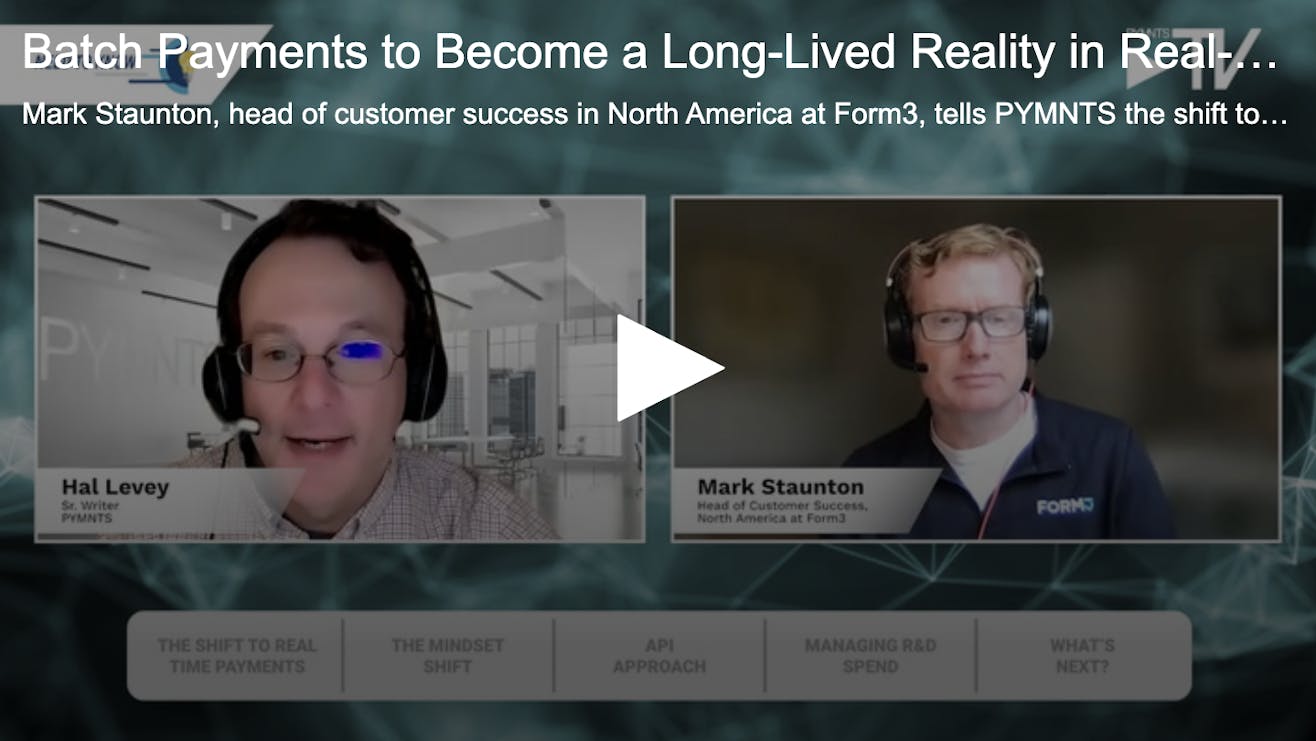Batch Payments to Become a Long-Lived Reality in Real-Time World
Thought Leadership· 3min June 21, 2023
The shift toward real-time payments won’t doom batch payments to extinction.
There’s room for co-existence, Mark Staunton, Head of Customer Success in North America at Form3, told PYMNTS, even when FedNow launches in the United States in just a matter of weeks.

An example has been set in the United Kingdom where real-time payments have been part of the payments landscape since 2008. The volume of payments transactions going through batch schemes still has a “bit of a lead” over those that move through the faster payments scheme, at about a 60%-to-40% ratio, he said.
We’ll continue to see growth in the volume of real-time payments across new use cases, he said, supported by the continued emergence of gig economy work, where individuals want (and value) the ability to be paid instantly when shifts or projects are completed.
“Immediate payments allow you to adapt to these types of use cases without upending existing bulk processes,” he said.
The co-existence of batch and real-time payments will likely be long-lived, he said, because while consumers may be used to transacting instantly with peers and expect to see funds settle immediately in their accounts, corporates have some catch-up to do when it comes to embracing real-time payments, or they risk losing customers to competitors.
“There’s a perceived hurdle on the initial changes that need to happen,” he said.
Moving from batch cycles — with two- or three-day cycles — to a 24/7/365, always-on functionality may indeed seem daunting.
Staunton observed that the traditional payment rails — underpinning single, high-value transactions or batched, low-value transactions — have evolved over decades.
Addressing the Core Restrictions
But now, as he told PYMNTS, “the core restriction is that you have to swap files. You have to send bulk batches of payments together because the technology and the central infrastructures have not been able to manage the volume of payments on a one-by-one basis.”
The pain points become glaring when it comes time to address exceptions or special circumstances with individual transactions that are batched with scores — sometimes hundreds and even thousands — of others. He offered up an example in which a company putting together payroll, a predictable activity that can be done in advance, may need to change a single employee’s account details. Or perhaps another worker has left the firm.
Taking a single transaction out of the bulk process becomes a challenge because of the complexities in managing reconciliation and other back-end activities, as the batches are broken up.
“There’s a lot of manual overhead and processing that results from the cleanup” of those one-offs or exceptions, he said. There are other inefficiencies with batch payments, as batches must be submitted by a certain daily deadline or else the company must wait for the next settlement cycle.
Myriad compliance issues must also be considered, he added.
“The various schemes have rules and requirements around giving the ‘use of funds’ to customers,” he noted. “So, it’s not just a matter of your books and your records; it’s actually pushing that up through the channels to your retail customers and your corporate customers.”
For the banks and corporates adapting to and adopting real-time payments, connectivity to managed payments services through an application programming interface (API) enables some “future-proofing” against regulatory and process changes while making sure new demands and use cases are served as they arise, Staunton said.
APIs provide flexibility to set up file connections quickly and launch new products and services in a streamlined manner, which in turn improves returns on investment in those initiatives, he said.
“There’s also the flexibility to do more with data,” said Staunton, which comes from being able to “integrate with APIs across all the multiple systems you may have in your banking world. You’ll have a ledger, you’ll have an investigation system, you’ll have a customer service system. They can all be fed independently from a set of APIs that give the right information to those who need it.”
“The more simplification you can have,” he said, “the easier your life is going to be.”
Originally published on PYMNTS.com
Written by
Mark Staunton is a Head of Customer Success at Form3. In the past 15 years Mark has gained valuable insight into the challenges of legacy payment processing on both the buy and sell side through working in cash management, settlement and reconciliations operations and payments product management at Goldman Sachs, J.P. Morgan Chase, Close Brothers and HSBC.”









 Back to News
Back to News

